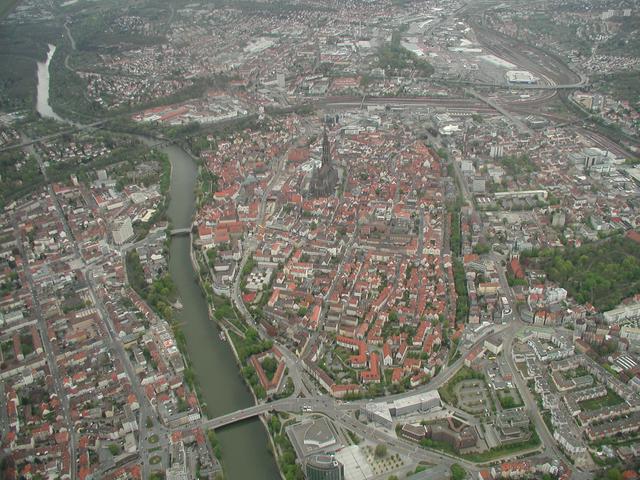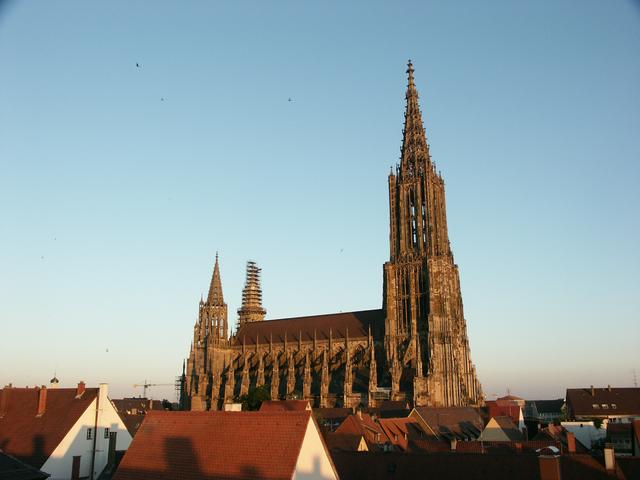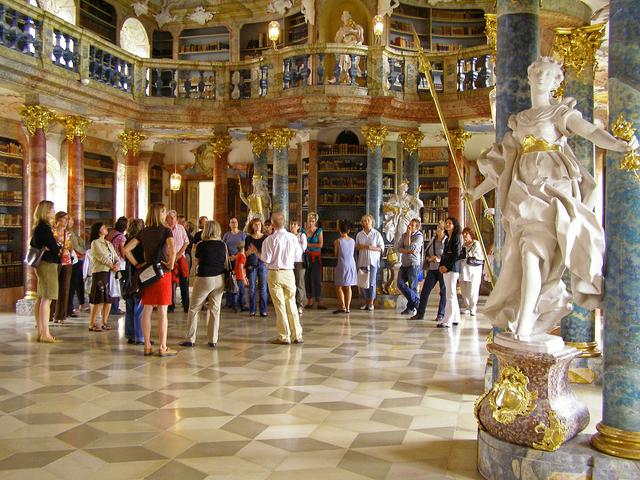Ulm is a town at the edge to Bavaria in Baden-Württemberg, south west Germany. It is home to the highest church steeple in the world (161.53m), even higher than the Cathedral (Dom in German) of Cologne.

With a population of 118,000 inhabitants Ulm forms an urban district and administrative center of the region. Ulm, founded around 850, is rich in history and traditions as a former Free Imperial City (German: freie Reichsstadt). Today, it is an economic center due to its varied industries, and it is the seat of a university. Internationally, Ulm is primarily known for having the church with the tallest steeple in the world (161.53 meter or 529.95 feet), the Gothic Ulm minster (German: Ulmer Münster) and as the birthplace of Albert Einstein.
Ulm lies at the Danube river and is surrounded by forests and hills which rise to altitudes of over 620 metres, which are part of the Swabian Mountains. Because of the Danube Ulm sees a lot of dense fog especially in late autumn and early spring. Most parts of the city, including the old town, are situated on the north-west bank of the Danube. On the other side of the river lies the twin city of Neu-Ulm in the state of Bavaria.
Around the city, there are many statues of sparrows (Spatzen). Spatzen is a nickname for the residents of Ulm and a symbol of the city. Legend says that, while building the cathedral, the workers couldn't figure out how to get the long wooden beams into the church until they noticed a sparrow entering its nest while holding a piece of straw lengthwise, instead of sideways.
Standard German is understood by everyone, but the local dialect is Swabian (Schwäbisch).
- Ulmer Münster, Münsterplatz 1, 89073 Ulm. Construction on this Gothic cathedral began in the 14th century, but the current version was only fully completed in 1890. The interior of the Münster contains gorgeous choir stalls by Jörg Syrlin (1469–1474) from the 15th century. The top of the steeple, which is the tallest in the world, can be reached by climbing 768 steps and offers an amazing view of Ulm and the region (4€ for adults). On clear days, it is possible to see the Alps.

- Fishermen's Quarter. a scenic old part of town with half-timbered houses, around the Blau River. Contains the crookedest hotel in the worldFishermen's and Tanners' Quarter
- Rathaus. With its ancient colorful painted walls and the astronomical clock (dating from 1520)
- Library. The library of Ulm, also known as "Glaspyramide" (glass pyramid), because of its architecture.
- Wiblingen Monastery, Schlossstraße 38, 89079 Ulm-Wiblingen, +49 731 5028975. Founded in 1092 by Benedictine monks. Points of interest are the late Baroque basilica and the Rococo library room. There is also a museum in the convent building. The monastery is the starting point of the Upper-Swabian Baroque Route

- Ulm Federal Fortifications. The largest preserved fortifications in Germany. Built from 1842 - 1859 to protect from attacks by France.
Ulmer Münster, Münsterplatz 1, 89073 Ulm. Construction on this [[Gothic architecture|Gothic]] cathedral began in the 14th century, but the current version was only fully completed in 1890. The interior of the Münster contains gorgeous choir stalls by Jörg Syrlin (1469–1474) from the 15th century. The top of the steeple, which is the tallest in the world, can be reached by climbing 768 steps and offers an amazing view of Ulm and the region (4€ for adults). On clear days, it is possible to see the [[Alps]].
Fishermen's Quarter. a scenic old part of town with half-timbered houses, around the Blau River. Contains the crookedest hotel in the world
Rathaus. With its ancient colorful painted walls and the astronomical clock (dating from 1520)
Library. The library of Ulm, also known as "Glaspyramide" (glass pyramid), because of its architecture.
Wiblingen Monastery, Schlossstraße 38, 89079 Ulm-Wiblingen, +49 731 5028975. Founded in 1092 by Benedictine monks. Points of interest are the late Baroque basilica and the Rococo library room. There is also a museum in the convent building. The monastery is the starting point of the Upper-Swabian Baroque Route
Ulm Federal Fortifications. The largest preserved fortifications in Germany. Built from 1842 - 1859 to protect from attacks by France.
- Narrensprung. The annual parade at the beginning of Carnival season.
- Ulm Tent Festival. Festival in Friedrichsau Parc. Famous artists from all kind of genres perform in the huge red and blue circus tent. Every year from May - July.
- Schwörmontag. A town festival that includes the serenade of lights, the historic oath and the Nabada, a water parade in the Danube (Donau) river. Every year on third weekend in July.
- Einstein Marathon. Every year. End of September.
- Christmas market. On the plaza in front of the Münster.
- Farmers' Market. Om Wednesday and Saturday in front of the Münster.
Narrensprung. The annual parade at the beginning of Carnival season.
Ulm Tent Festival. Festival in Friedrichsau Parc. Famous artists from all kind of genres perform in the huge red and blue circus tent. Every year from May - July.
Schwörmontag. A town festival that includes the serenade of lights, the historic oath and the Nabada, a water parade in the Danube (Donau) river. Every year on third weekend in July.
Einstein Marathon. Every year. End of September.
Christmas market. On the plaza in front of the Münster.
Farmers' Market. Om Wednesday and Saturday in front of the Münster.
The UlmCard is available from the Tourist Information office. It provides entry to the Weishaupt Gallery, Ulm Museum, Museum of Bread Culture, Danube Swabian Museum, Edwin Scharff Museum, Museum at Wiblingen Monastery and Rococo library, Natural History Education Centre, and Children's Museum Neu-Ulm along with many other advantages.
- Museum of Bread Culture. In the Old City, dedicated to the 6,000-year history of bread.
- Kunsthalle Weishaupt. A modern art museum.
- Ulmer Museum. Containing ancient and modern art, including the world's oldest zoomorphic figurine.
- Danube Swabian Museum, Obere Donaubastion, 89073 Ulm. Covers the history of the Danube Swabians.
- Wiblingen Monastery Convent Museum. Exhibition about the secular aspects of the monastery's history.
- Stadthaus Ulm (Town House). Built by start architect Richard Meier. Changing exhibitions of contemporary art.
- Natural History Education Center. Scientific collections of the history of earth and the flora and fauna.
Museum of Bread Culture. In the Old City, dedicated to the 6,000-year history of bread.
Kunsthalle Weishaupt. A modern art museum.
Ulmer Museum. Containing ancient and modern art, including the world's oldest zoomorphic figurine.
Danube Swabian Museum, Obere Donaubastion, 89073 Ulm. Covers the history of the Danube Swabians.
Wiblingen Monastery Convent Museum. Exhibition about the secular aspects of the monastery's history.
Stadthaus Ulm (Town House). Built by start architect Richard Meier. Changing exhibitions of contemporary art.
Natural History Education Center. Scientific collections of the history of earth and the flora and fauna.
- Walk along the Donau (Danube) river and the city wall and through the Fischerviertel. Visit the many art galleries there. See the Schiefes Haus (Crooked House) and enjoy the nice and little houses with very little streets between and small rivers. Visit the birthplace of Albert Einstein. Today the site of the house where he was born is marked with a memorial.
- Take a cruise on the Donau with the historic ship 'Ulmer Spatz'. Regularly tours during summer. Starting near the Metzgerturm.
Walk along the Donau (Danube) river and the city wall and through the Fischerviertel. Visit the many art galleries there. See the Schiefes Haus (Crooked House) and enjoy the nice and little houses with very little streets between and small rivers. Visit the birthplace of Albert Einstein. Today the site of the house where he was born is marked with a memorial.
- The major shopping street starts at the train station and leads directly to the Ulmer Münster church.
- Shopping mall 'Blautalcenter'
The major shopping street starts at the train station and leads directly to the Ulmer Münster church.
There are plenty of places to eat in the nice and quiet Fischerviertel, where you can get some genuine German food and beer.
- Zur Forelle, Fischergasse 25, +49 731 63924. Very good German fish and meat dishes.
- Hemperium, Zinglerstraße 1, +49 731 30200. Restaurant/bar where various meals made from the (impotent) male hemp plant are served. Prices are very attractive and food is good.
- Kornhäusle, Kornhausgasse 8, +49 731 1517311. A cozy small restaurant which serves crèpes (yummy salty French pancakes), also very nice.
- Gaststätte zur Stadt Heidenheim. Big meals, Biergarten during summer.
Zur Forelle, Fischergasse 25, +49 731 63924. Very good German fish and meat dishes.
Hemperium, Zinglerstraße 1, +49 731 30200. Restaurant/bar where various meals made from the (impotent) male hemp plant are served. Prices are very attractive and food is good.
Kornhäusle, Kornhausgasse 8, +49 731 1517311. A cozy small restaurant which serves crèpes (yummy salty French pancakes), also very nice.
Gaststätte zur Stadt Heidenheim. Big meals, Biergarten during summer.
- Barfüßer, Paulstraße 4, Neu-Ulm, +49 731 974480. The Barfüßer restaurants brew their own beer. There is also one Barfüßer beer garden directly at the Danube.
- Murphy's Law, Keltergasse 3, +49 731 6021467. Murphy's Law is an Irish Pub.
- Schlössle, Schlössleweg 3, Neu-Ulm, +49 731 77390. The Schlössle is perhaps one of the nicest beer gardens and can be reached within a 15min walk from the city. They also serve their own beer.
Barfüßer, Paulstraße 4, Neu-Ulm, +49 731 974480. The Barfüßer restaurants brew their own beer. There is also one Barfüßer beer garden directly at the Danube.
Murphy's Law, Keltergasse 3, +49 731 6021467. Murphy's Law is an Irish Pub.
Schlössle, Schlössleweg 3, Neu-Ulm, +49 731 77390. The Schlössle is perhaps one of the nicest beer gardens and can be reached within a 15min walk from the city. They also serve their own beer.
There are a lot of internet cafes all over the town. Just ask.
You can get free internet access at the new Stadtbibliothek (city library), next to the Rathaus (city hall). They have about 30 PC there. WLAN (Wi-Fi) is also available there.
- Neu-Ulm (Bavaria)
- Bad Schussenried
- Augsburg
- Stuttgart
- Tübingen
- Legoland Germany, about 30km NE of Ulm
- Blautopf, the source of the Blau River, in Blaubeuren, 16km west of Ulm
